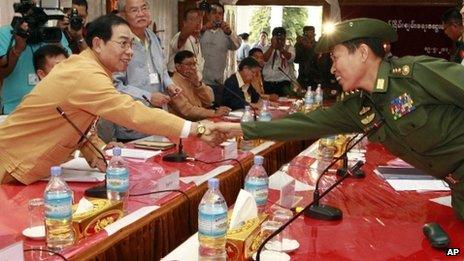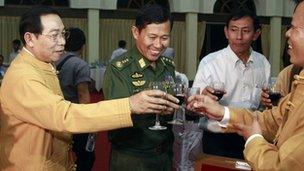Burma's ethnic conflicts see slow progress to resolution
- Published

Shan State Army leader Yawd Suk (left) shakes hand with General Soe Win from the Burmese Army.
The Burmese authorities are trying to reach lasting peace agreements with the country's many ethnic groups, but it is proving a long and complex process, as the BBC's Jonah Fisher reports.
"Six, seven… hold on probably a few more than that," said David Mathieson, furrowing his brow as he listed Burma's armed groups.
"The Karen, the Karenni, the Shan, the Kachin, the Chin, the United Wa State Army, the Mon, the Mongla… have I forgotten anyone?"
Mr Mathieson, a researcher for Human Rights Watch, has been following developments in Burma closely for the last decade, but understanding its many ethnic wars is enough to give even the most seasoned observer a headache.
We travelled through Shan State to witness one small part of Burma's multi-pronged peace process. Started by President Thein Sein last August, its aim is to bring the country's many festering conflicts to a close.
Our invitation was to accompany the rebel Shan State Army, along with a large group of Thai and Burmese journalists and "Bob", their smartly dressed and secretive American military adviser.
For Khuen Sae, a veteran Burmese journalist, it was a first proper trip back home for almost 45 years. When he finished school in 1969, he joined the rebel Mong Tai army.
Then, when its warlord leader, Khun Sa, surrendered in 1996, he went into exile in Thailand and started a news agency.
"I feel both excited and sad at the same time," he said.
Whether by accident or because there were no other accommodation options, the Burmese authorities lodged the Shan delegation at a highly sensitive location.
The New Keng Tung hotel is built on the site of what the Shan see as one of the biggest acts of cultural desecration carried out by the ethnic Burmese. In 1991 a Shan royal palace was destroyed here to make way for new buildings.
"When a Burmese palace went into ruins, they rebuilt it." Khuen Sae said. "But they destroyed this one and it was still in existence. This is an example of why the non-Burmese are fighting against the Burmese."
'Trust him'
But the choice of hotel did not seem to concern the Shan State Army and their leader, Yawd Serk, too much.
With a fighting force of about 5,000 men, the rebels control small pockets of land near the Thai border and are limited to guerrilla attacks against the Burmese military. For them, President Thein Sein's offer of talks presented a way out.
"The president's announcement of reconciliation and invitation to the armed groups is why we came here," Yawd Serk said. "I trust him, that's why I'm here and why we've stopped fighting."
So in a large room at a military guesthouse overlooking Keng Tung, 11 Shan State Army representatives wearing traditional orange tunics sat opposite 11 representatives from the Burmese authorities.
In the past, ethnic groups had complained that agreements reached with the government negotiating team carried little weight with the Burmese military on the ground.

Shan leaders and Burmese army generals toast the negotiations
This time, there were plenty of men in military fatigues.
Alongside Aung Min, Burma's Railways Minister and chief negotiator, sat Soe Win, the deputy commander in chief of the Burmese army, and three regional commanders who operate in Shan State.
The deal they reached after a day of talks was aimed at consolidating December's ceasefire agreement. The exact boundaries of each side's territory was committed to paper and safe areas for displaced people established.
But this was, more than anything, about building trust and paving the way for future discussions. The government's current strategy is ambitious, some might say impossible.
"The president has adopted a three-stage roadmap. The first stage is the ceasefire agreements, the second stage political dialogue and then the third stage is a national meeting of all the ethnic groups," Minister Aung Min said after the talks.
"We are planning to complete the process by 2015 within the tenure of this parliament."
Communication 'breakdown'
That national meeting has been nicknamed "Panglong II" and is due to replace the first Panglong agreement.
That treaty, signed in 1947 by - among others - Aung San San Kyi's father, established the "full autonomy in internal administration" of what was then called Burma's "Frontier Areas", namely the Shan, Chin and Kachin people. For all its noble intentions, it counted for little once the military had taken over.
But while some groups have accepted the offer of talks and a ceasefire, other conflicts discovered new life. In Kachin in the far north, tens of thousands of people have been displaced by clashes in the last few weeks between rebels and government troops.
Some see that as proof that parts of the Burmese army are not following a presidential order calling for restraint, and evidence of a schism between reformers and the military.
The official word from the government delegation at the talks was that the Kachin fighting was due to a "breakdown of communication to remote areas".
Ceasefires being signed and subsequently breaking down have become a recurring part of Burma's post-independence history.
In part, that is because of the fundamental incompatibility of ethnic groups wanting autonomy while the Burmese military tried to impose a strong centralised system.
But with the new civilian-lead government of President Thein Sein and the fast pace of reforms has come a degree of optimism.
"It's going to be incredibly difficult because a lot of the claims by different groups are really quite different," said David Mathieson of Human Rights Watch.
"The size of the groups and the territories they occupy are also very different but it's not beyond the realms of possibility."